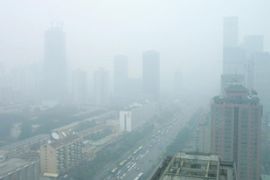Brown cloud ‘costs lives and crops’
UN says food prices set to escalate due to heavy pollution across Asia.

If the cloud, now three-kilometres deep, disperses, global temperatures could rise by up to two degrees.
Christian Teriete from the World Wildlife Fund’s Global Climate Change programme told Al Jazeera that the cloud is highly toxic.
“It will effect many people’s health and their respiratory systems,” he said.
“The unusual weather patterns will also affect the output of grain and rice in the region, resulting in higher food costs. But it is not too late to take action, for example, switching from fossile fuels, to solar or wind power … but at the moment we see a bad trend that could lead to devastating consequences.”
Complex impact
According to the report, the pollutants may hold temperatures down overall, but the mix of particles means it is also speeding up warming in some of the most vulnerable areas and exacerbating the devastating impacts of higher temperatures.
The complex impact of the cloud, which tends to cool areas near the surface of the Earth and warm the air higher up, is believed to be causing a shortening of the monsoon season in India while increasing flooding there and in southern China.
Soot from the cloud is also deposited on glaciers, which are at the centre of environmentalists’ and politicians’ concerns because they feed Asia’s rivers and provide drinking water for billions of people who live along them.
There the particles capture more solar heat than white, reflective snow and ice – speeding up the melting of a key resource.
At a monitoring station near Mount Everest, soot is said to have been found at levels which scientists say would be expected in urban areas.
Human cost
There is also a human cost. The report estimates that at least 340,000 people are dying prematurely because of damage to their lungs and hearts and due to cancers.
Scientists are still studying the impact on crops, but possible problems include falling harvests because of less energy for photosynthesis and higher ozone concentrations.
“The emergence of the atmospheric brown cloud problem is expected to further aggravate the recent dramatic escalation of food prices and the consequent challenge for survival among the world’s most vulnerable populations,” the report said.
There are similar brown clouds over parts of Europe, North America, Africa and the Amazon Basin, though research so far has been focused on the Asian cloud which stretches from the Arabian Peninsula to the Pacific Ocean.